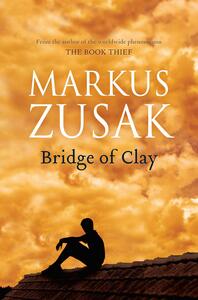Take a photo of a barcode or cover
I throughly enjoyed this book! It was a little confusing at first & sometimes hard to follow. Once I caught on I was hooked! I just loved how it wasn't an atypical family & shows that we're all human.
The emotional punch of the whole story coming out in the end made the slower middle parts worth it. The language was distractingly poetic at points and after fifty pages I almost quit reading but the relationship between Clay, Michael, and Penny jumpstarted my
Interest again and concluded tragically and beautifully.
Interest again and concluded tragically and beautifully.
4.5; the first 50 pages I was confused, but I really loved this once I got into it.
Love Markus Zusak but found this one a little slow for my taste. Also growing up in a rambunctious house of 5 boys, I could relate to some of the shenanigans the Dunbar boys got into. It was a moving book, but in the end, I was a little glad it ended.
This is Zusak’s first novel after his almost-universally-loved The Book Thief. Bridge of Clay is not in the same league but this story of love, grief and forgiveness is worth reading nonetheless.
The five Dunbar brothers (Matthew, Rory, Henry, Clay and Tommy), “a family of ramshackle tragedy” (8), live in a suburb of Sydney, Australia. There are no adults in the home but there is a menagerie, “a small roster of dysfunctional pets” (15) which includes Achilles, a mule; Hector, a cat; Agamemnon, a goldfish; and Telemachus, a pigeon. One day, the boys’ father, who abandoned them after the death of their mother, visits and asks his sons to help him build a bridge across a river near his home. The boys refer to their father only as “the Murderer”, so Clay’s decision to join him is seen as a betrayal. What follows is the story of Clay’s helping build a physical bridge while also trying to reconnect a fragmented family: “The bridge will be made of [Clay]” (180).
Matthew, the eldest, is the narrator, but he focuses on the fourth brother, Clay: “Everything happened to him. We were all of us changed through him” (9). Clay is the quiet, enigmatic brother who serves as the family historian; as a child he always asked his parents for stories about their pasts. Clay is also fascinated with Michelangelo and with Carey Novac, a neighbourhood girl focused on becoming a jockey. For a reason not divulged until the end, Clay carries a clothes peg with him. It is repeatedly mentioned that he has great heart: “’He’s got a heart like Goddamn Phar Lap’” (473).
At first, the book is a challenging read. A large cast of characters is introduced and it is initially difficult to keep track of who is who. Gradually, distinct personalities emerge. Each of the Dunbar boys has one specific trait that differentiates him. For example, Rory is the one always looking for a fight while Henry is the one always looking for a way to make money. The narrative moves back and forth to different times and places. There is a linear plot in the present but it is chopped up with flashbacks to past events in the lives of various people, especially those of the boys’ parents and grandparents. Like the blocks used to complete a bridge, these flashbacks gradually provide a complete picture by explaining the reasons for people’s behaviours, behaviours which at the beginning are indeed perplexing.
Matthew’s description of his family illustrates the style used throughout the novel:
“Us Dunbar boys
From oldest to youngest:
Me, Rory, Henry, Clayton, Thomas.
We would never be the same.
To be fair, though, neither would he – and to give you at least a small taste of what the Murderer was entering into, I should tell you what we were like:
Many considered us tearaways.
Barbarians.
Mostly they were right:
Our mother was dead.
Our father had fled.
We swore like bastards, fought like contenders, and punished each other at pool, at table tennis (always on third- or fourth-hand tables, and often set up on the lumpy grass of the backyard), at Monopoly, darts, football, cards, at everything we could get our hands on.
We had a piano no one played.
Our TV was serving a life sentence.
The couch was in for twenty” (14-15).
Anyone not liking this style should perhaps pass on the book because it has 500+ pages.
Chapters often end with teasers like “In those lives before they had us, there were still two chapters left” (213) and “It was all in what was to come” (285) and “We loved what you did next” (114) and “it was strange to think, but he’d marry that girl one day” (143). This heavy-handed foreshadowing becomes annoying after a while, especially because revelations are meted out slowly, in dribs and drabs.
Like in The Book Thief, death shows up as a character: “She’d go straight back to work, of course, though death was at her shoulder. No more hanging from the power lines for that old guy. Or draping round the fridge. But he was always out there somewhere: On a train or a bus, or footpath. On the way back home to here” (478) and “There was no point closing the curtains, or locking any of the doors. It was in there, out there, waiting. It lived on our front porch” (479).
The bridge is a metaphor for reconnecting a fractured family. Clay builds both a physical bridge across a river and a metaphorical bridge between his father and his brothers. In many ways, reading this book is like building a bridge: it is a task requiring work and patience, but the effort is worthwhile.
Please check out my reader's blog (https://schatjesshelves.blogspot.com/) and follow me on Twitter (@DCYakabuski).
The five Dunbar brothers (Matthew, Rory, Henry, Clay and Tommy), “a family of ramshackle tragedy” (8), live in a suburb of Sydney, Australia. There are no adults in the home but there is a menagerie, “a small roster of dysfunctional pets” (15) which includes Achilles, a mule; Hector, a cat; Agamemnon, a goldfish; and Telemachus, a pigeon. One day, the boys’ father, who abandoned them after the death of their mother, visits and asks his sons to help him build a bridge across a river near his home. The boys refer to their father only as “the Murderer”, so Clay’s decision to join him is seen as a betrayal. What follows is the story of Clay’s helping build a physical bridge while also trying to reconnect a fragmented family: “The bridge will be made of [Clay]” (180).
Matthew, the eldest, is the narrator, but he focuses on the fourth brother, Clay: “Everything happened to him. We were all of us changed through him” (9). Clay is the quiet, enigmatic brother who serves as the family historian; as a child he always asked his parents for stories about their pasts. Clay is also fascinated with Michelangelo and with Carey Novac, a neighbourhood girl focused on becoming a jockey. For a reason not divulged until the end, Clay carries a clothes peg with him. It is repeatedly mentioned that he has great heart: “’He’s got a heart like Goddamn Phar Lap’” (473).
At first, the book is a challenging read. A large cast of characters is introduced and it is initially difficult to keep track of who is who. Gradually, distinct personalities emerge. Each of the Dunbar boys has one specific trait that differentiates him. For example, Rory is the one always looking for a fight while Henry is the one always looking for a way to make money. The narrative moves back and forth to different times and places. There is a linear plot in the present but it is chopped up with flashbacks to past events in the lives of various people, especially those of the boys’ parents and grandparents. Like the blocks used to complete a bridge, these flashbacks gradually provide a complete picture by explaining the reasons for people’s behaviours, behaviours which at the beginning are indeed perplexing.
Matthew’s description of his family illustrates the style used throughout the novel:
“Us Dunbar boys
From oldest to youngest:
Me, Rory, Henry, Clayton, Thomas.
We would never be the same.
To be fair, though, neither would he – and to give you at least a small taste of what the Murderer was entering into, I should tell you what we were like:
Many considered us tearaways.
Barbarians.
Mostly they were right:
Our mother was dead.
Our father had fled.
We swore like bastards, fought like contenders, and punished each other at pool, at table tennis (always on third- or fourth-hand tables, and often set up on the lumpy grass of the backyard), at Monopoly, darts, football, cards, at everything we could get our hands on.
We had a piano no one played.
Our TV was serving a life sentence.
The couch was in for twenty” (14-15).
Anyone not liking this style should perhaps pass on the book because it has 500+ pages.
Chapters often end with teasers like “In those lives before they had us, there were still two chapters left” (213) and “It was all in what was to come” (285) and “We loved what you did next” (114) and “it was strange to think, but he’d marry that girl one day” (143). This heavy-handed foreshadowing becomes annoying after a while, especially because revelations are meted out slowly, in dribs and drabs.
Like in The Book Thief, death shows up as a character: “She’d go straight back to work, of course, though death was at her shoulder. No more hanging from the power lines for that old guy. Or draping round the fridge. But he was always out there somewhere: On a train or a bus, or footpath. On the way back home to here” (478) and “There was no point closing the curtains, or locking any of the doors. It was in there, out there, waiting. It lived on our front porch” (479).
The bridge is a metaphor for reconnecting a fractured family. Clay builds both a physical bridge across a river and a metaphorical bridge between his father and his brothers. In many ways, reading this book is like building a bridge: it is a task requiring work and patience, but the effort is worthwhile.
Please check out my reader's blog (https://schatjesshelves.blogspot.com/) and follow me on Twitter (@DCYakabuski).
Beautifully perfect. Messy, gorgeous, complicated, raw. Forgiveness, family, love, grief. Everything. This was mesmerizing. Though hard to read, forcing you to be concentrated and not speed ahead, this is great. The writing is obviously really good. YES
emotional
sad
medium-paced
“Bridge of Clay” is in a way, an wonderful coming-of-age story that feels partly at times, a jumbled mess. Parts of the novel were very good at telling the story, while there were some that had me either lost or confused. Despite those flaws, Zusak still manages to deliver a solid story (Grade: B+).
More like a 4.5-4.75, but the beginning was a tad tough for me to get into. This ended up being a beautifully crafted and intricate story as Zusak books typically are! Highly recommend!




